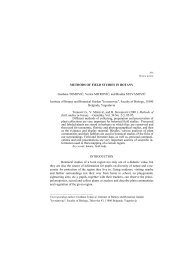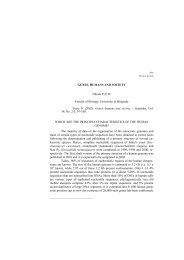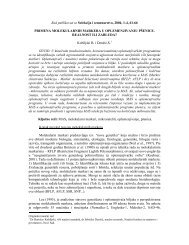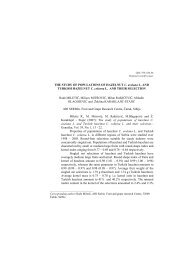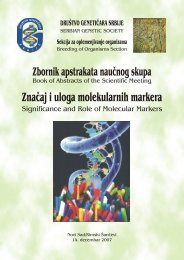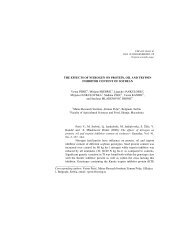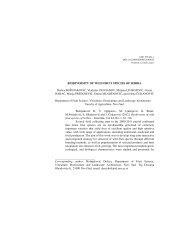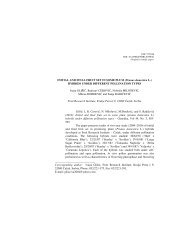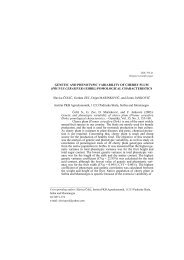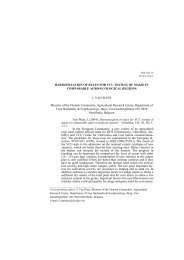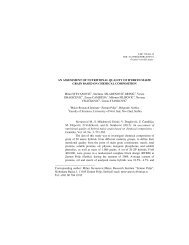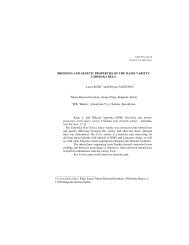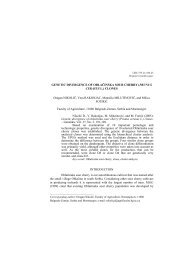Zbornik - Društvo genetičara Srbije
Zbornik - Društvo genetičara Srbije
Zbornik - Društvo genetičara Srbije
You also want an ePaper? Increase the reach of your titles
YUMPU automatically turns print PDFs into web optimized ePapers that Google loves.
IV-Pos-46 ZBORNIK ABSTRAKATA III KONGRESA GENETIÈARA SRBIJE 163<br />
Subotica, 30. novembar - 4. decembar 2004.<br />
GENI VIRULENTNOSTI I AVIRULENTNOSTI U POPULACIJI PARAZITA<br />
Puccinia coronata avenae<br />
Mirjana Staletiæ, S. Stojanoviæ i M. Milovanoviæ<br />
Institut za istraivanja u poljoprivredi «SRBIJA», Centar za strna ita, Kragujevac<br />
Ispitivanja su obavljena u 1999. i 2000. godini u Centru za strna ita u Kragujevcu.<br />
Uzorci uredospora su prikupljeni sa razlièitih sorti ovsa u 23 lokaliteta na podruèju<br />
<strong>Srbije</strong>. U laboratoriji su dobijene èiste kulture, kojima je inokulisan set izogenih linija sa<br />
Pc genima: Pc38, Pc39, Pc48, Pc50, Pc50-2, Pc54-1, Pc54-2, Pc55, Pc56, Pc58, Pc59,<br />
Pc60, Pc61, Pc62, Pc63, Pc64, Pc67 i Pc68. Geni virulentnosti P. coronata avenae su<br />
identifikovani na osnovama uzajamnih odnosa gena po teoriji «gen za gen» (Flor, 1955).<br />
Utvrðeno je postojanje 23 razlièite formule virulentnosti. Broj gena virulentnosti u<br />
identifikovanim patotipovima se kretao od 2 do 12. Najvirulentniji je bio patotip sa<br />
genima virulentnosti V48, V50, V50-2, V55, V56, V58, V59, V60, V61, V62, V64 i<br />
V67, dok je sa dva gena virulentnosti (V63+V68) bio samo jedan patotip. Najveæi broj<br />
patotipova imao je 5, 6, 7i8gena virulentnosti, dok je ukupan odnos virulentnih prema<br />
avirulentnim genima odgovarao teoretskom odnosu 1:2. Najveæu frekvenciju su imali<br />
geni virulentnosti V54-2, V64, V67, V61, V50-2, V62, V60 i V50, a najmanju V63, V58,<br />
V54-1, V59, V38, V48, V55, V56, V39 i V68.<br />
Dobijeni rezultati pokazuju da je genetièka varijabilnost virulentnosti P. coronata avenae<br />
u Srbiji u 1999. i 2000. godini bila visoka, što upuæuje na neophodnost iznalaenja novih<br />
donora Pc gena otpornosti radi njihovog korišæenja u oplemenjivanju ovsa na otpornost<br />
prema ovom patogenu.<br />
THE VIRULENCE AND A VIRULENCE GENES IN POPULATION OF<br />
PARASITE Puccinia coronata avenae<br />
Investigations were performed during 1999. and 2000. years in Center for small grains in<br />
Kragujevac. The samples of uredo-spores were collected from different oats cultivars in<br />
23 locations of Serbia. In laboratory were obtained pure cultures, and by them was inoculated<br />
the set of isogenic lines with Pc genes: Pc38, Pc39, Pc48, Pc50, Pc50-2, Pc54-1,<br />
Pc54-2, Pc55, Pc56, Pc58, Pc59, Pc60, Pc61, Pc62, Pc63, Pc64, Pc67, and Pc68. The virulence<br />
genes of P. coronata avenae were identified on the basis of mutual relations of<br />
genes according to theory «gene for gene».<br />
The existence of 23 different formulas of virulence was established. The number of virulence<br />
genes in identified patho-types was 2 to 12. The most virulent was patho-type with<br />
genes of virulence V48, V50, V50-2, V55, V56, V58, V59, V60, V61, V62, V64, and<br />
V67, until with two virulence genes (V63+V68) was only one patho-type. The greatest<br />
number of patho-types had 5,6,7 and 8 virulence genes, until the total relation of virulent<br />
to a virulent genes was in accordance with theoretic relation 1:2. The most frequent were<br />
virulence genes V54-2, V64, V67, V61, V50-2, V62, V60, and V50, and the least frequent<br />
were V63, V58, V54-1, V59, V38, V48, V55, V56, V39 and V68.<br />
Obtained results point out that in 1999. and 2000. seasons, the genetic variability of virulence<br />
of P. coronata avenae in Serbia was high, which demonstrates on necessity of<br />
search of new donors of Pc genes of resistance for theirs future usage in oat breeding for<br />
resistance to this pathogen.



